Play video — original link
Play video
Play video
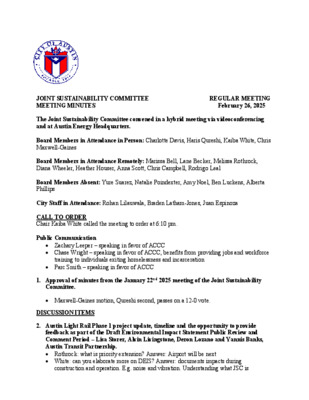
February 26, 2025 JOINT SUSTAINABILITY COMMITTEE REGULAR MEETING MEETING MINUTES The Joint Sustainability Committee convened in a hybrid meeting via videoconferencing and at Austin Energy Headquarters. Board Members in Attendance in Person: Charlotte Davis, Haris Qureshi, Kaiba White, Chris Maxwell-Gaines Board Members in Attendance Remotely: Marissa Bell, Lane Becker, Melissa Rothrock, Diana Wheeler, Heather Houser, Anna Scott, Chris Campbell, Rodrigo Leal Board Members Absent: Yure Suarez, Natalie Poindexter, Amy Noel, Ben Luckens, Alberta Phillips City Staff in Attendance: Rohan Lilauwala, Braden Latham-Jones, Juan Espinoza CALL TO ORDER Chair Kaiba White called the meeting to order at 6:10 pm. Public Communication • Zachary Leeper – speaking in favor of ACCC • Chase Wright – speaking in favor of ACCC, benefits from providing jobs and workforce training to individuals exiting homelessness and incarceration • Parc Smith – speaking in favor of ACCC 1. Approval of minutes from the January 22nd 2025 meeting of the Joint Sustainability Committee. DISCUSSION ITEMS • Maxwell-Gaines motion, Qureshi second, passes on a 12-0 vote. 2. Austin Light Rail Phase 1 project update, timeline and the opportunity to provide feedback as part of the Draft Environmental Impact Statement Public Review and Comment Period – Lisa Storer, Alvin Livingstone, Deron Lozano and Yannis Banks, Austin Transit Partnership. • Rothrock: what is priority extension? Answer: Airport will be next • White: can you elaborate more on DEIS? Answer: documents impacts during construction and operation. E.g. noise and vibration. Understanding what JSC is interested in is helpful. Federal gov’t doesn’t require level of detail being provided. E.g. working with city arborist to come up with tree preservation-first approach. • Model shows 20 million + VMT reduced. All electric vehicles. 3. Austin Civilian Conservation Corps Update on staffing, current agreements, pathways, and its future funding opportunities. – Juan Espinoza, Economic Development Department. • Davis: what happened to other pathways? Espinoza: funding shortfall meant that only natural systems pathway is active. Program has always been funded with one-time funding. • White: how much funding is needed to bring programming back? Espinoza: $2.8m at max capacity. 4. Comprehensive Climate Implementation Program Update – Braden Latham-Jones, Office of Climate Action and Resilience. • White: what about public-facing items? Latham-Jones – some items feature this. • White: will this come back to JSC? Latham-Jones: TBD, depends on timeline. 5. Recommendations and possible action on the Comprehensive Climate Implementation Program, including supportive action and/or recommendations for additions …
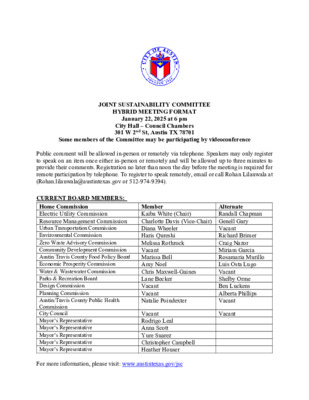
JOINT SUSTAINABILITY COMMITTEE HYBRID MEETING FORMAT January 22, 2025 at 6 pm City Hall – Council Chambers 301 W 2nd St, Austin TX 78701 Some members of the Committee may be participating by videoconference Public comment will be allowed in-person or remotely via telephone. Speakers may only register to speak on an item once either in-person or remotely and will be allowed up to three minutes to provide their comments. Registration no later than noon the day before the meeting is required for remote participation by telephone. To register to speak remotely, email or call Rohan Lilauwala at (Rohan.lilauwala@austintexas.gov or 512-974-9394). Alternate Randall Chapman Member Kaiba White (Chair) Charlotte Davis (Vice-Chair) Genell Gary Diana Wheeler Haris Qureshi Melissa Rothrock Vacant CURRENT BOARD MEMBERS: Home Commission Electric Utility Commission Resource Management Commission Urban Transportation Commission Environmental Commission Zero Waste Advisory Commission Community Development Commission Austin Travis County Food Policy Board Marissa Bell Economic Prosperity Commission Water & Wastewater Commission Parks & Recreation Board Design Commission Planning Commission Austin/Travis County Public Health Commission City Council Mayor’s Representative Mayor’s Representative Mayor’s Representative Mayor’s Representative Mayor’s Representative Amy Noel Chris Maxwell-Gaines Lane Becker Vacant Vacant Natalie Poindexter Vacant Rodrigo Leal Anna Scott Yure Suarez Christopher Campbell Heather Houser For more information, please visit: www.austintexas.gov/jsc Vacant Richard Brimer Craig Nazor Miriam Garcia Rosamaria Murillo Luis Osta Lugo Vacant Shelby Orme Ben Luckens Alberta Phillips Vacant Vacant Committee. DISCUSSION members. Budget. AGENDA CALL TO ORDER PUBLIC COMMUNICATION: GENERAL The first 10 speakers signed up prior to the meeting being called to order will each be allowed a three-minute allotment to address their concerns regarding items not posted on the agenda. APPROVAL OF MINUTES 1. Approval of minutes from the December 18th, 2024 meeting of the Joint Sustainability 2. Discussion of Joint Sustainability Committee membership, expiring terms, and replacement 3. Discussion of potential Joint Sustainability Committee Recommendations for the FY26 City 4. Update from Electric Utility Commission on Solar Programs – Kaiba White. 5. Update from Austin Travis County Food Policy Board on draft recommendations for consideration by the Joint Sustainability Committee – Marissa Bell. 6. Update from The Austin Travis County Public Health Commission on an approved recommendation to improve the supportive services provided to Community Health Workers – Natalie Poindexter. DISCUSSION AND ACTION ITEMS FUTURE AGENDA ITEMS ADJOURNMENT The City of Austin is committed to compliance with the American with Disabilities Act. Reasonable modifications and …
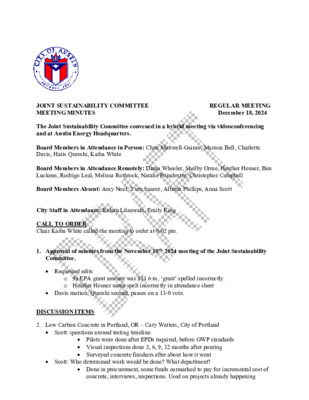
JOINT SUSTAINABILITY COMMITTEE REGULAR MEETING December 18, 2024 MEETING MINUTES The Joint Sustainability Committee convened in a hybrid meeting via videoconferencing and at Austin Energy Headquarters. Board Members in Attendance in Person: Chris Maxwell-Gaines, Marissa Bell, Charlotte Davis, Haris Qureshi, Kaiba White Board Members in Attendance Remotely: Diana Wheeler, Shelby Orme, Heather Houser, Ben Luckens, Rodrigo Leal, Melissa Rothrock, Natalie Poindexter, Christopher Campbell Board Members Absent: Amy Noel, Yure Suarez, Alberta Phillips, Anna Scott City Staff in Attendance: Rohan Lilauwala, Emily King CALL TO ORDER Chair Kaiba White called the meeting to order at 6:02 pm. 1. Approval of minutes from the November 18th, 2024 meeting of the Joint Sustainability Committee. • Requested edits DISCUSSION ITEMS o 9a EPA grant amount was $31.6 m, ‘grant’ spelled incorrectly. o Heather Houser name spelt incorrectly in attendance sheet • Davis motion, Qureshi second, passes on a 13-0 vote. 2. Low Carbon Concrete in Portland, OR – Cary Watters, City of Portland • Scott: questions around testing timeline • Pilots were done after EPDs required, before GWP standards • Visual inspections done 3, 6, 9, 12 months after pouring • Surveyed concrete finishers after about how it went • Scott: Who determined work would be done? What department? • Done in procurement, some funds earmarked to pay for incremental cost of concrete, interviews, inspections. Used on projects already happening (ramps, sidewalk sections, etc.). No exact amount, but estimate of only a few thousand dollars. • Portland has an internal materials testing lab performing QA testing on construction materials used by the city, this was part of regular workflow. • Scott: what were barriers? • Biggest: resistance from private suppliers. • Next steps: training, support at pre-bid meetings, reestablish conversation on how to expand program and lower GWP over time, slowly but surely. Also looking into expanding into materials like asphalt. 3. Austin’s Urban Forest – Emily King, Development Services Department • Davis: What is trend of tree removals vs canopy cover o Priorities in order: preserve trees on site, plant more trees on site, payments to mitigation fund, which supports Urban Forest Grant. o Supports community groups + additional trees in city projects • Have we estimated cost of achieving 50% tree canopy cover goal o Maintenance units are only funded to be able to do reactionary tree work, not on proactive maintenance plans. There is a maintenance gap. We don’t have a …

BOARD/COMMISSION RECOMMENDATION Austin-Travis County Food Policy Board Recommendation Number: (YYYYMMDD-XXX) (XXX is the agenda item number): Support for Agricultural Land Acquisition and Preservation in Austin, Texas WHEREAS, the 2022 City of Austin State of the Food System Report indicates that less than 0.6% of the food consumed in Travis County is produced locally, and that approximately 16.8 acres of farmland are lost daily to development pressures, underscoring the critical need for dedicated agricultural land preservation efforts; and WHEREAS, land in the Capital Region is continuing to increase in value and decrease in quantity, it is imperative to act quickly as the cost of action will only increase over time; and WHEREAS, agricultural lands are vital to local food security, environmental sustainability, emergency preparedness, and climate resilience; and WHEREAS, the Austin/Travis County Food Plan, approved by the Austin City Council in October 2024, includes strategic, measurable, and time-bound goals and strategies to strengthen food security, promote environmental sustainability, and address climate change; and WHEREAS, the Austin/Travis County Food Plan’s Goal 1 prioritizes expanding community food production, preserving agricultural lands, and increasing the amount of farmland dedicated to regenerative food production long-term in Austin and Travis County; and WHEREAS, Strategy 1.1 of the Food Plan calls for the preservation of land for food production in Central Texas through conservation easements, fee-simple purchases, and land-banking, ensuring that farmland remains dedicated to agricultural use; and WHEREAS, Strategy 1.2 directs the City of Austin and Travis County to pursue capital funding sources to finance the conservation of land for agricultural use through conservation easements or direct purchases; and WHEREAS, preserving agricultural land also supports the goals of the Austin Climate Equity Plan by promoting sustainable land use, strengthening local food systems, and reducing carbon footprints through localized food production; and WHEREAS, Natural Systems Goal 2 of the Austin Climate Equity Plan aims to protect 500,000 acres of farmland across the five-county region through legal conservation or regenerative agriculture programs by 2030; and WHEREAS, the City of Austin currently lacks a dedicated mechanism to effectively manage and prioritize the preservation of agricultural lands; WHEREAS, the Austin-Travis County Food Policy Board’s Recommendation Number 20240318-7 urged the City of Austin to allocate funds and create a full-time equivalent (FTE) position to support the implementation of the Food Plan; and NOW, THEREFORE, BE IT RESOLVED that the Austin-Travis County Food Policy Board encourages the Austin City Council to allocate …
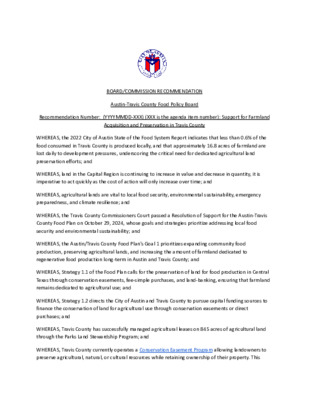
BOARD/COMMISSION RECOMMENDATION Austin-Travis County Food Policy Board Recommendation Number: (YYYYMMDD-XXX) (XXX is the agenda item number): Support for Farmland Acquisition and Preservation in Travis County WHEREAS, the 2022 City of Austin State of the Food System Report indicates that less than 0.6% of the food consumed in Travis County is produced locally, and that approximately 16.8 acres of farmland are lost daily to development pressures, underscoring the critical need for dedicated agricultural land preservation efforts; and WHEREAS, land in the Capital Region is continuing to increase in value and decrease in quantity, it is imperative to act quickly as the cost of action will only increase over time; and WHEREAS, agricultural lands are vital to local food security, environmental sustainability, emergency preparedness, and climate resilience; and WHEREAS, the Travis County Commissioners Court passed a Resolution of Support for the Austin-Travis County Food Plan on October 29, 2024, whose goals and strategies prioritize addressing local food security and environmental sustainability; and WHEREAS, the Austin/Travis County Food Plan’s Goal 1 prioritizes expanding community food production, preserving agricultural lands, and increasing the amount of farmland dedicated to regenerative food production long-term in Austin and Travis County; and WHEREAS, Strategy 1.1 of the Food Plan calls for the preservation of land for food production in Central Texas through conservation easements, fee-simple purchases, and land-banking, ensuring that farmland remains dedicated to agricultural use; and WHEREAS, Strategy 1.2 directs the City of Austin and Travis County to pursue capital funding sources to finance the conservation of land for agricultural use through conservation easements or direct purchases; and WHEREAS, Travis County has successfully managed agricultural leases on 845 acres of agricultural land through the Parks Land Stewardship Program; and WHEREAS, Travis County currently operates a Conservation Easement Program allowing landowners to preserve agricultural, natural, or cultural resources while retaining ownership of their property. This program, funded by voter-approved bond funds and supplemented by donations, has successfully preserved significant tracts of land and helps protect vital resources such as watersheds, wildlife habitats, and agricultural lands; and WHEREAS, the Conservation Easement Program has been a key tool for Travis County in its efforts to protect land from development, with more than $24.9 million approved by voters between 2011 and 2017 for the purchase of easements. The program prioritizes properties in conservation corridors and those with significant environmental or agricultural value, aligning with the broader goals of the Austin/Travis County …
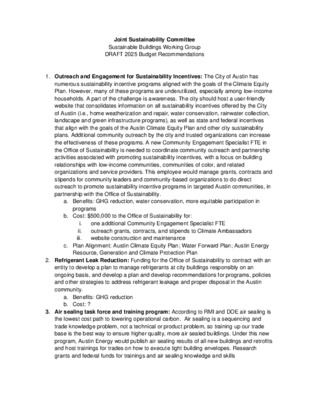
Joint Sustainability Committee Sustainable Buildings Working Group DRAFT 2025 Budget Recommendations 1. Outreach and Engagement for Sustainability Incentives: The City of Austin has numerous sustainability incentive programs aligned with the goals of the Climate Equity Plan. However, many of these programs are underutilized, especially among low-income households. A part of the challenge is awareness. The city should host a user-friendly website that consolidates information on all sustainability incentives offered by the City of Austin (i.e., home weatherization and repair, water conservation, rainwater collection, landscape and green infrastructure programs), as well as state and federal incentives that align with the goals of the Austin Climate Equity Plan and other city sustainability plans. Additional community outreach by the city and trusted organizations can increase the effectiveness of these programs. A new Community Engagement Specialist FTE in the Office of Sustainability is needed to coordinate community outreach and partnership activities associated with promoting sustainability incentives, with a focus on building relationships with low-income communities, communities of color, and related organizations and service providers. This employee would manage grants, contracts and stipends for community leaders and community-based organizations to do direct outreach to promote sustainability incentive programs in targeted Austin communities, in partnership with the Office of Sustainability. a. Benefits: GHG reduction, water conservation, more equitable participation in programs b. Cost: $500,000 to the Office of Sustainability for: one additional Community Engagement Specialist FTE outreach grants, contracts, and stipends to Climate Ambassadors i. ii. iii. website construction and maintenance c. Plan Alignment: Austin Climate Equity Plan; Water Forward Plan; Austin Energy Resource, Generation and Climate Protection Plan 2. Refrigerant Leak Reduction: Funding for the Office of Sustainability to contract with an entity to develop a plan to manage refrigerants at city buildings responsibly on an ongoing basis, and develop a plan and develop recommendations for programs, policies and other strategies to address refrigerant leakage and proper disposal in the Austin community. a. Benefits: GHG reduction b. Cost: ? 3. Air sealing task force and training program: According to RMI and DOE air sealing is the lowest cost path to lowering operational carbon. Air sealing is a sequencing and trade knowledge problem, not a technical or product problem, so training up our trade base is the best way to ensure higher quality, more air sealed buildings. Under this new program, Austin Energy would publish air sealing results of all new buildings and retrofits and host …
Play video
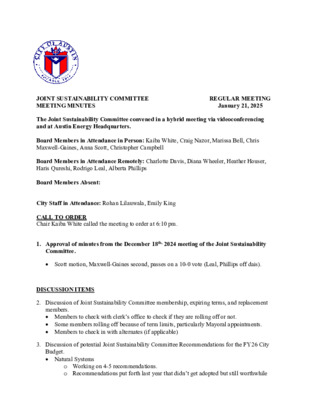
January 21, 2025 JOINT SUSTAINABILITY COMMITTEE REGULAR MEETING MEETING MINUTES The Joint Sustainability Committee convened in a hybrid meeting via videoconferencing and at Austin Energy Headquarters. Board Members in Attendance in Person: Kaiba White, Craig Nazor, Marissa Bell, Chris Maxwell-Gaines, Anna Scott, Christopher Campbell Board Members in Attendance Remotely: Charlotte Davis, Diana Wheeler, Heather Houser, Haris Qureshi, Rodrigo Leal, Alberta Phillips Board Members Absent: City Staff in Attendance: Rohan Lilauwala, Emily King CALL TO ORDER Chair Kaiba White called the meeting to order at 6:10 pm. 1. Approval of minutes from the December 18th, 2024 meeting of the Joint Sustainability Committee. • Scott motion, Maxwell-Gaines second, passes on a 10-0 vote (Leal, Phillips off dais). DISCUSSION ITEMS 2. Discussion of Joint Sustainability Committee membership, expiring terms, and replacement members. • Members to check with clerk’s office to check if they are rolling off or not. • Some members rolling off because of term limits, particularly Mayoral appointments. • Members to check in with alternates (if applicable) 3. Discussion of potential Joint Sustainability Committee Recommendations for the FY26 City Budget. • Natural Systems o Working on 4-5 recommendations. o Recommendations put forth last year that didn’t get adopted but still worthwhile o Items being discussed in the climate equity plan implementation o Converting impervious cover to functional green – audit of city owned land o Land acquisition, in eastern watersheds o Citywide green infrastructure vision, implementation strategy o Green workforce o Wildfire prevention o Tree canopy survey/assessment using LIDAR • Consumption o Looked at previous recommendations from 2024 and 2023. In 2023, 100% adoption. In 2024, near zero adoption. o Looking at reinstating the climate ambassador program o Citywide sustainable purchasing o Low carbon concrete o Food plan implementation o Zero waste and circular restaurant materials o Electric landscape equipment • Transportation still working • Buildings o Outreach/engagement for sustainability incentives o Refrigerants – reducing leaks, switching to different refrigerants o Air sealing task force o Water leak detection and landscape conversions o Sustainable construction procurement coordinator o ACCC support 4. Update from Electric Utility Commission on Solar Programs – Kaiba White • Update on solar standard offer, allows building owners to lease roof space to solar developers. First stakeholder meeting scheduled for expansion of program on Jan 29. • Solar for All moving slower because interlocal agreement with Harris County needed to be completed. 5. Update from Austin Travis County …
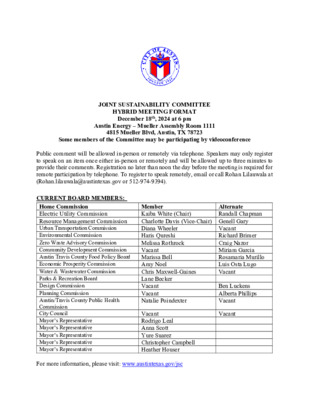
JOINT SUSTAINABILITY COMMITTEE HYBRID MEETING FORMAT December 18th, 2024 at 6 pm Austin Energy – Mueller Assembly Room 1111 4815 Mueller Blvd, Austin, TX 78723 Some members of the Committee may be participating by videoconference Public comment will be allowed in-person or remotely via telephone. Speakers may only register to speak on an item once either in-person or remotely and will be allowed up to three minutes to provide their comments. Registration no later than noon the day before the meeting is required for remote participation by telephone. To register to speak remotely, email or call Rohan Lilauwala at (Rohan.lilauwala@austintexas.gov or 512-974-9394). Alternate Randall Chapman Member Kaiba White (Chair) Charlotte Davis (Vice-Chair) Genell Gary Diana Wheeler Haris Qureshi Melissa Rothrock Vacant CURRENT BOARD MEMBERS: Home Commission Electric Utility Commission Resource Management Commission Urban Transportation Commission Environmental Commission Zero Waste Advisory Commission Community Development Commission Austin Travis County Food Policy Board Marissa Bell Economic Prosperity Commission Water & Wastewater Commission Parks & Recreation Board Design Commission Planning Commission Austin/Travis County Public Health Commission City Council Mayor’s Representative Mayor’s Representative Mayor’s Representative Mayor’s Representative Mayor’s Representative Amy Noel Chris Maxwell-Gaines Lane Becker Vacant Vacant Natalie Poindexter Vacant Rodrigo Leal Anna Scott Yure Suarez Christopher Campbell Heather Houser For more information, please visit: www.austintexas.gov/jsc Vacant Richard Brimer Craig Nazor Miriam Garcia Rosamaria Murillo Luis Osta Lugo Vacant Ben Luckens Alberta Phillips Vacant Vacant Committee. DISCUSSION AGENDA CALL TO ORDER PUBLIC COMMUNICATION: GENERAL The first 10 speakers signed up prior to the meeting being called to order will each be allowed a three-minute allotment to address their concerns regarding items not posted on the agenda. APPROVAL OF MINUTES 1. Approval of minutes from the November 20th, 2024 meeting of the Joint Sustainability 2. Low Carbon Concrete in Portland, OR – Cary Watters, City of Portland 3. Austin’s Urban Forest – Emily King, Development Services Department 4. Discussion of Joint Sustainability Committee preparation to make recommendations for the FY 25-26 budget 5. Discussion of updated JSC priorities for the Land Acquisition Fund 6. Update on the Austin Energy Resource, Generation and Climate Protection Plan – Kaiba White, Electric Utility Commission 7. Update on the Congress Avenue Urban Design plans – Diana Wheeler, Urban Transportation Commission 8. Update on PFAS water testing and the approval of the Water Forward 2024 plan, Water Conservation Plan, and the Drought Contingency Plan – Chris Maxwell-Gaines, Water and Wastewater Commission …

JOINT SUSTAINABILITY COMMITTEE REGULAR MEETING November 20, 2024 MEETING MINUTES The Joint Sustainability Committee convened in a hybrid meeting via videoconferencing and at Austin Energy Headquarters. Board Members in Attendance in Person: Kaiba White, Chris Maxwell-Gaines, Charlotte Davis, Anna Scott, Marissa Bell, Haris Qureshi Board Members in Attendance Remotely: Diana Wheeler, Amy Noel, Lane Becker, Rodrigo Leal, Christopher Campbell, Heather House Board Members Absent: Yure Suarez, Natalie Poindexter, Melissa Rothrock City Staff in Attendance: Zach Baumer, Braden Latham-Jones, Angela Baucom, Sara Norris, Amy Everhart, Lisa Martin CALL TO ORDER Chair Kaiba White called the meeting to order at 6:07 pm. 1. Approval of minutes from the October 23rd, 2024 meeting of the Joint Sustainability Committee. • Commissioners request edits: o Notation standardization o Discussion item #5 of land acquisition has no content underneath it. Please revise to say “the committee discussed the item” in lieu of leaving it blank o Clean up the consistency of how the commissioners are referred to (first initial and last name, or other). Please standardize throughout. • Approved 12-0 on Qureshi motion, Maxwell-Gaines second. DISCUSSION AND ACTION ITEMS 2. Recommendation in support of the city pursuing a Low Carbon Transportation Materials Grant (moved up from 7) a. City is pursuing this. Discussion of letter in support. Vote would be to add the JSC to the letter with the intention of having other local organizations sign on as well. Due date is Monday. b. Diana Wheeler moves to approve JSC signing onto letter and Anna seconds c. Unanimous approval 3. Recommendation on Austin Energy Generation Plan (moved up from 6) a. Lisa Martin with AE presented: Resource Generation Plan last one was adopted in 2020 and a lot of new risks have been identified, including growth in population, data centers and AI, changes in weather and climate impacts, and changes in the ERCOT market. Council in 2022 directed AE to update the plan, and since then AE has been working on the process to update it along with a 40 member stakeholder group representing a diverse group of Austinites to move towards meeting the full range of needs in a reliable and affordable way. The plan will be published and shared next week in draft form and will be voted on by council in December. The plan itself focused on addressing risks by starting with prioritizing customer energy solutions. Once those are maximized, looking at how …

CITY OF PORTLAND LOW CARBON CONCRETE INITIATIVE City of Austin Joint Sustainability Commission December 18th, 2024 Cary Watters Sustainable Procurement Program Manager Agenda • Origin of the initiative • Initiative development • Pilot projects • Embodied carbon threshold • Exemptions • Misconceptions • Lessons learned • Open discussion 2 Origin of the initiative 2016 Sustainable Supply Chain Analysis 3 Timeline of City and State Partnership to Advancement of Low Carbon Concrete City of Portland Concrete EPD Requirements for City Projects City of Portland Buy Clean policy developed Advisory committee Data collection Pilot projects Concrete Embodied Carbon (GWP) Threshold Requirements 2016 2017 2018 2019 2020 2021 2022 2023 State of Oregon Concrete EPD Incentive Program Buy Clean legislation introduced, did not pass Buy Clean legislation introduced again, did not pass Buy Clean Oregon Passes (DOT only) State of Oregon 4 Steps in the initiative: Convened a committee of stakeholders. 1. 2. 3. 4. 5. Established a product-specific EPD requirement for concrete mixes used on City projects Established a baseline average EPD for Portland area for Portland cement concrete Conducted pilot tests of lower-embodied carbon concrete mixes Established requirements for GWP thresholds for concrete mixes 5 Step 1: Low Carbon Concrete Committee Representing Stakeholder Type City of Portland – Sustainable Procurement Program City Bureau/Committee Convener City of Portland – Water Bureau City of Portland – Bureau of Transportation City of Portland – Bureau of Environmental Services - Materials Testing Lab Oregon Department of Environmental Quality 4 Portland area ready-mix suppliers 3 structural and materials engineers 3 contractors – residential, commercial, infrastructure Architect City Bureau City Bureau City Bureau Engineers Contractor Designer Subject Matter Expert – Low Carbon Concrete Concrete Producers 6 Step 2: City of Portland Low Carbon Concrete Procurement Policy for EPDs 7 Step 2: City of Portland Low Carbon Concrete Procurement Policy for EPDs • EPDs are submitted as part of the specifications submittal for a concrete mix • Our staff reviews EPD for: • Is the EPD current (not expired) • Is the EPD 3rd-party verified • Rare issues concrete EPD • One Bureau submitted the EPD for the cement, but not the ready-mix 8 Step 3: Determine a baseline • GWP range of the 1100 published EPDs in Portland region (2019) • 17 plants, 4 producers • Portland skewed higher than PNW average 9 EPD Mobile Mix Concrete in Portland • Link to EPD for Mobile Mix Concrete …

Austin's Tree Canopy Presentation for the Joint Sustainability Committee D e c e m b e r 2 0 2 4 Presentation Overview • Austin's urban forest stats • How equity fits in • Additional tools Significant Benefits https://texasforestinfo.tamu.edu/urbanforeststats/assets/standard/AustinTX2022.pdf 2022 Tree Canopy & Plantable Space Heading 41% Canopy Cover 39K Acres of new canopy needed to meet 50% canopy cover goal. https://storymaps.arcgis.com/stories/d9ba0b99c60b4b8395414a09c4533949 The City of Austin measures tree canopy every 4 years using the calculation: tree canopy area divided by land area. The canopy cover number uses the City of Austin's boundary, inclusive of full purpose, limited purpose, and extraterritorial jurisdictions in May 2023. Analysis provided by Alan Halter, IT Geospatial Analyst Senior, Development Services Department, Urban Forest Program Growing our canopy, equitably Community Tree Priority Map • Organized into 2 categories: • High • Low • Includes 9 data inputs in these categories: • Environment • Social Vulnerability • Community Investment • Health & Well-Being https://www.austintexas.gov/blog/explore-austins-community-tree-priority-map Additional tools My City's Trees • Urban Forest Inventory and Analysis data • • Inventory statistics Summary Reports https://mct.tfs.tamu.edu/app Additional tools Tree Canopy • National tree canopy database • View tree canopy cover and land cover classes • Planning tool built-in https://hub.treesatwork.org/ Emily King Urban Forester Emily.King@AustinTexas.gov Follow Nature in the City for events, updates, job postings, and more! facebook.com/NatureCityATX instagram.com/NatureCityATX
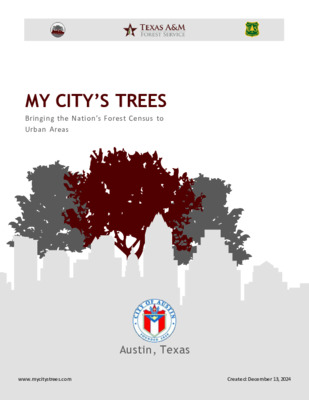
MY CITY’S TREES Bringing the Nation’s Forest Census to Urban Areas Austin, Texas www.mycitystrees.com Created: December 13, 2024 INTRODUCTION Information presented in this report comes from the USDA Forest Service’s Urban Forest Inventory & Analysis (FIA) program. The Austin publication, Austin's Urban Forest, 2014, contains detailed information about the inventory. Readers are encouraged to view the publication to learn more about the Urban FIA program, inventory methods, assessment, and management implications. My City’s Trees is a web application enabling access and exploration of a city’s urban forest using Urban FIA data, U.S. Census data, and thematic spatial data. This report was generated from My City’s Trees on December 13, 2024. Austin, TX was selected for city, land cover was selected for theme, and Developed - Open, Developed - Low, Developed - Medium, Developed - High, Deciduous / Mixed Forest, Evergreen Forest, Shrub / Herbaceous, and Water / Barren were selected for classes (described below). Land cover classes are based on the 2019 National Land Cover Database (MRLC). CLASS Developed - Open Developed - Low Developed - Medium Developed - High Deciduous / Mixed Forest Evergreen Forest Shrub / Herbaceous Water / Barren DESCRIPTION Open space on developed land Low intensity developed land Medium intensity developed land High intensity developed land Deciduous forest, mixed forest, and woody wetland lands Evergreen forest land Shrub/scrub, grassland/herbaceous, pasture/hay, and cultivated crop lands Open water, barren land, and emergent herbaceous wetlands The city boundary is from the 2010 U.S. Census. The sample data used in this report were collected from 2014 to 2021. Population data is from the 2020 U.S. Census. Questions and comments about this application may be directed to Rebekah Zehnder, Texas A&M Forest Service, at (979) 458-6630 or mct@tfs.tamu.edu. Links My City’s Trees: www.mycitystrees.com Austin's Urban Forest, 2014: http://www.nrs.fs.fed.us/pubs/50393 Urban FIA Program: https://www.fs.usda.gov/research/programs/urbanfia A Note about Sampling Error Estimates are based on a sample and are therefore subject to sampling error. Urban FIA is designed to provide reliable estimates at the population level (e.g., the city boundary). In general, with more specific My City’s Trees • Austin, TX 2 www.mycitystrees.com estimates (e.g., publicly owned versus all ownerships, specific species, single class of theme, etc.) sampling errors will increase and the reliability of the estimate will decrease. Sampling errors should be considered in any application of the estimates presented here. While sampling errors are not included per se, the number of plots used …
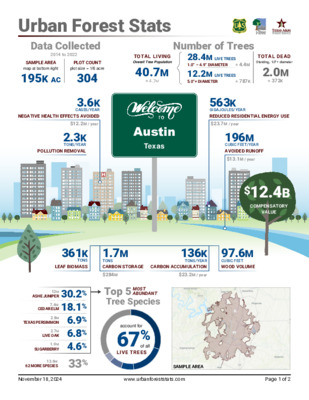
TOTAL LIVING Overall Tree Population 40.7M ± 4.7M Number of Trees 28.4M LIVE TREES 1.0” – 4.9” DIAMETER ± 4.4M 12.2M LIVE TREES 5.0”+ DIAMETER ± 787K TOTAL DEAD Standing, 1.0”+ diameter 2.0M ± 372K Urban Forest Stats Data Collected 2014 to 2022 SAMPLE AREA map at bottom right PLOT COUNT plot size = 1/6 acre 195K AC 304 CASES/YEAR NEGATIVE HEALTH EFFECTS AVOIDED 3.6K $12.2M / year 2.3K TONS/YEAR POLLUTION REMOVAL Austin Texas 563K $23.7M / year GIGAJOULES/YEAR REDUCED RESIDENTIAL ENERGY USE 196M CUBIC FEET/YEAR AVOIDED RUNOFF $13.1M / year $12.4B COMPENSATORY VALUE 361K TONS LEAF BIOMASS 1.7M TONS CARBON STORAGE TONS/YEAR CARBON ACCUMULATION $284M $23.2M / year 136K 97.6M CUBIC FEET WOOD VOLUME ASHE JUNIPER CEDAR ELM TEXAS PERSIMMON LIVE OAK SUGARBERRY 12M 30.2% 7.4M 18.1% 2.8M 6.9% 2.7M 6.8% 1.9M 4.6% 13.6M 33% 62 MORE SPECIES Top 5 MOST ABUNDANT Tree Species account for 67% of all LIVE TREES November 18, 2024 www.urbanforeststats.com Page 1 of 2 SAMPLE AREA Urban Forest Stats CONTINUED Austin’s Top 3 Tree Species LAND USE OWNERSHIP RESIDENTIAL OTHER DEVELOPED FOREST OTHER PUBLIC PRIVATE account for 14% of OTP account for 6% of OTP account for 80% of OTP account for <1% of OTP account for 55% of OTP account for 45% of OTP Cedar elm 775K Ashe juniper 630K Sugarberry 553K 5.75M TREES on 51.9K RESIDENTIAL AC Ashe juniper 410K Texas persimmon 287K Live oak 236K 2.46M TREES on 82.6K DEVELOPED AC Ashe juniper 11.2M Cedar elm 6.5M Texas persimmon 2.2M 32.4M TREES on 48.2K FOREST AC Ashe juniper 57K Honey mesquite 9.2K None — 66.5K TREES on 12.5K OTHER AC OVERALL TREE POPULATION DIAMETER (INCHES) Ashe juniper 6.3M Cedar elm 6.3M Texas persimmon 2.8M 28.4M Ashe juniper 4.2M Live oak 866K Cedar elm Ashe juniper 1.8M Live oak 687K Cedar elm Live oak 108K Ashe juniper 72K Pecan 743K 8.16M 348K 3.74M 19K 323K TREES with diameters 1.0” to 4.9” TREES with diameters 5.0” to 9.9” TREES with diameters 10.0” to 19.9” TREES with diameters 20.0” or greater Ashe juniper 7.3M Cedar elm 4.8M Chinese tallowtree 1.8M 22.3M TREES on 68.8K PUBLIC AC Ashe juniper 5.0M Cedar elm 2.5M Live oak 1.7M 18.3M TREES on 122.3K PRIVATE AC OVERALL TREE POPULATION MAINTAINED AREA Live oak 639K Sugarberry 603K Cedar elm 431K 4.59M TREES in areas MAINTAINED Ashe juniper 12.1M Cedar elm 6.9M Texas persimmon 2.6M 36.1M TREES in areas NOT MAINTAINED …
Play video
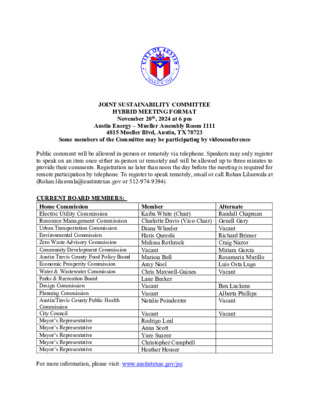
JOINT SUSTAINABILITY COMMITTEE HYBRID MEETING FORMAT November 20th, 2024 at 6 pm Austin Energy – Mueller Assembly Room 1111 4815 Mueller Blvd, Austin, TX 78723 Some members of the Committee may be participating by videoconference Public comment will be allowed in-person or remotely via telephone. Speakers may only register to speak on an item once either in-person or remotely and will be allowed up to three minutes to provide their comments. Registration no later than noon the day before the meeting is required for remote participation by telephone. To register to speak remotely, email or call Rohan Lilauwala at (Rohan.lilauwala@austintexas.gov or 512-974-9394). Alternate Randall Chapman Member Kaiba White (Chair) Charlotte Davis (Vice-Chair) Genell Gary Diana Wheeler Haris Qureshi Melissa Rothrock Vacant CURRENT BOARD MEMBERS: Home Commission Electric Utility Commission Resource Management Commission Urban Transportation Commission Environmental Commission Zero Waste Advisory Commission Community Development Commission Austin Travis County Food Policy Board Marissa Bell Economic Prosperity Commission Water & Wastewater Commission Parks & Recreation Board Design Commission Planning Commission Austin/Travis County Public Health Commission City Council Mayor’s Representative Mayor’s Representative Mayor’s Representative Mayor’s Representative Mayor’s Representative Amy Noel Chris Maxwell-Gaines Lane Becker Vacant Vacant Natalie Poindexter Vacant Rodrigo Leal Anna Scott Yure Suarez Christopher Campbell Heather Houser For more information, please visit: www.austintexas.gov/jsc Vacant Richard Brimer Craig Nazor Miriam Garcia Rosamaria Murillo Luis Osta Lugo Vacant Ben Luckens Alberta Phillips Vacant Vacant AGENDA CALL TO ORDER PUBLIC COMMUNICATION: GENERAL The first 10 speakers signed up prior to the meeting being called to order will each be allowed a three-minute allotment to address their concerns regarding items not posted on the agenda. APPROVAL OF MINUTES 1. Approval of minutes from the October 23rd, 2024 meeting of the Joint Sustainability Committee. DISCUSSION Sustainability Norris, Austin Energy Marissa Bell 2. Austin Climate Equity Plan Implementation Update – Braden Latham-Jones, Office of 3. Heat Pump Survey Response and Strategy – Zach Baumer, Office of Sustainability, and Sara 4. Update from Austin-Travis County Food Plan on Food Plan Implementation Resolution - 5. Update from Austin-Travis County Public Health Commission regarding draft recommendations for Community Health Workers, goals and priorities for 2025, and public health weather-related issues and flu season – Natalie Poindexter DISCUSSION AND ACTION ITEMS 6. Recommendation on Austin Energy Generation Plan Grant 7. Recommendation in support of the City pursuing a Low Carbon Transportation Materials FUTURE AGENDA ITEMS ADJOURNMENT The City of Austin is committed …

JOINT SUSTAINABILITY COMMITTEE HYBRID MEETING FORMAT November 20th, 2024 at 6 pm Austin Energy – Mueller Assembly Room 1111 4815 Mueller Blvd, Austin, TX 78723 Some members of the Committee may be participating by videoconference Public comment will be allowed in-person or remotely via telephone. Speakers may only register to speak on an item once either in-person or remotely and will be allowed up to three minutes to provide their comments. Registration no later than noon the day before the meeting is required for remote participation by telephone. To register to speak remotely, email or call Rohan Lilauwala at (Rohan.lilauwala@austintexas.gov or 512-974-9394). Alternate Randall Chapman Member Kaiba White (Chair) Charlotte Davis (Vice-Chair) Genell Gary Diana Wheeler Haris Qureshi Melissa Rothrock Vacant CURRENT BOARD MEMBERS: Home Commission Electric Utility Commission Resource Management Commission Urban Transportation Commission Environmental Commission Zero Waste Advisory Commission Community Development Commission Austin Travis County Food Policy Board Marissa Bell Economic Prosperity Commission Water & Wastewater Commission Parks & Recreation Board Design Commission Planning Commission Austin/Travis County Public Health Commission City Council Mayor’s Representative Mayor’s Representative Mayor’s Representative Mayor’s Representative Mayor’s Representative Amy Noel Chris Maxwell-Gaines Lane Becker Vacant Vacant Natalie Poindexter Vacant Rodrigo Leal Anna Scott Yure Suarez Christopher Campbell Heather Houser For more information, please visit: www.austintexas.gov/jsc Vacant Richard Brimer Craig Nazor Miriam Garcia Rosamaria Murillo Luis Osta Lugo Vacant Ben Luckens Alberta Phillips Vacant Vacant AGENDA ADDENDUM CALL TO ORDER PUBLIC COMMUNICATION: GENERAL APPROVAL OF MINUTES DISCUSSION 8. Discussion of process of identifying and acquiring land in accordance of City of Austin Resolution No. 20240814-024 on Creating a Dedicated Land Acquisition Fund – Charlotte Davis 9. Update from Resource Management Commission on Austin Energy's Solar for All grant from the U.S. Environmental Protection Agency – Charlotte Davis DISCUSSION AND ACTION ITEMS FUTURE AGENDA ITEMS ADJOURNMENT The City of Austin is committed to compliance with the American with Disabilities Act. Reasonable modifications and equal access to communications will be provided upon request. Meeting locations are planned with wheelchair access. If requiring Sign Language Interpreters or alternative formats, please give notice at least 2 days (48 hours) before the meeting date. Please contact Rohan Lilauwala at rohan.lilauwala@austintexas.gov or 512-974-9394 for additional information; TTY users’ route through Relay Texas at 711. For more information on the Joint Sustainability Committee, please email or call Rohan Lilauwala at rohan.lilauwala@austintexas.gov or 512-974-9394.

JOINT SUSTAINABILITY COMMITTEE REGULAR MEETING MEETING MINUTES October 23, 2024 The Joint Sustainability Committee convened in a hybrid meeting via videoconferencing and at City Hall. Board Members in Attendance in Person: Kaiba White, Rodrigo Leal, Marissa Bell, Chris Maxwell-Gaines, Charlotte Davis Board Members in Attendance Remotely: Amy Noel, Lane Becker, Diana Wheeler, Heather Houser, Melissa Rothrock, Anna Scott, Chris Campbell Board Members Absent: Yure Suarez, Jon Salinas, Haris Qureshi, Natalie Poindexter City Staff in Attendance: Leti Alvarez Jim Dymkowski Daniel Priest Naomi Rotramel CALL TO ORDER Chair Kaiba White called the meeting to order at 6:09 pm. 1. Approval of minutes from the September 25, 2024 meeting of the Joint Sustainability Committee. Chris Maxwell-Gaines motion, Houser seconds, passes 12-0. PUBLIC COMMUNICATION: GENERAL 2. Presentation on low-carbon concrete – Johanna Anderson, EPA • K. White –Clarification on Federal highway/transportation departments is already utilizing concrete that’s already in the top 20% of best? o Johanna – Federal funding flows to the development of the building of highways is it goes from the federal highways department directly to state department of transportations and then they use that funding to build roads. • Bell – Procurement, curious do you imagine people utilizing these labels without limiting fair and open competition and meeting any procurement regulations that are required o Johanna – Initially you might give extra points for a product that has a label. Like any new sustainable product on the marketplace, one might set up a separate agreement for the sustainable products versus the lesser. Market availability, purchasers will have to do their due diligence and provide situation-by-situation basis. • Kaiba – Looks like this grant closes 11/25, will they be able to get something together in a month? o Johanna – In general grant programs there’s a real interest in reaching folks that are not professional grant writers so I would assume that the federal highways grant is going that way also. • Anna Scott – How to we implement this? And how to we implement faster? o Johanna – There are tools already. I would say see how the federal government is doing it. Looking at how to take the approach, prioritizing, finding partners most willing, testing out carbon concrete, see what work is being done. • K. White – You talked about standards for the environmental product declarations, should we expect that they’re automatically adhering to those standards? Are they …
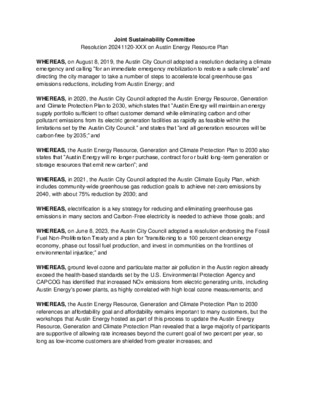
Joint Sustainability Committee Resolution 20241120-XXX on Austin Energy Resource Plan WHEREAS, on August 8, 2019, the Austin City Council adopted a resolution declaring a climate emergency and calling “for an immediate emergency mobilization to restore a safe climate” and directing the city manager to take a number of steps to accelerate local greenhouse gas emissions reductions, including from Austin Energy; and WHEREAS, in 2020, the Austin City Council adopted the Austin Energy Resource, Generation and Climate Protection Plan to 2030, which states that “Austin Energy will maintain an energy supply portfolio sufficient to offset customer demand while eliminating carbon and other pollutant emissions from its electric generation facilities as rapidly as feasible within the limitations set by the Austin City Council.” and states that “and all generation resources will be carbon-free by 2035;” and WHEREAS, the Austin Energy Resource, Generation and Climate Protection Plan to 2030 also states that “Austin Energy will no longer purchase, contract for or build long-term generation or storage resources that emit new carbon”; and WHEREAS, in 2021, the Austin City Council adopted the Austin Climate Equity Plan, which includes community-wide greenhouse gas reduction goals to achieve net-zero emissions by 2040, with about 75% reduction by 2030; and WHEREAS, electrification is a key strategy for reducing and eliminating greenhouse gas emissions in many sectors and Carbon-Free electricity is needed to achieve those goals; and WHEREAS, on June 8, 2023, the Austin City Council adopted a resolution endorsing the Fossil Fuel Non-Proliferation Treaty and a plan for “transitioning to a 100 percent clean energy economy, phase out fossil fuel production, and invest in communities on the frontlines of environmental injustice;” and WHEREAS, ground level ozone and particulate matter air pollution in the Austin region already exceed the health-based standards set by the U.S. Environmental Protection Agency and CAPCOG has identified that increased NOx emissions from electric generating units, including Austin Energy's power plants, as highly correlated with high local ozone measurements; and WHEREAS, the Austin Energy Resource, Generation and Climate Protection Plan to 2030 references an affordability goal and affordability remains important to many customers, but the workshops that Austin Energy hosted as part of this process to update the Austin Energy Resource, Generation and Climate Protection Plan revealed that a large majority of participants are supportive of allowing rate increases beyond the current goal of two percent per year, so long as low-income customers are shielded …